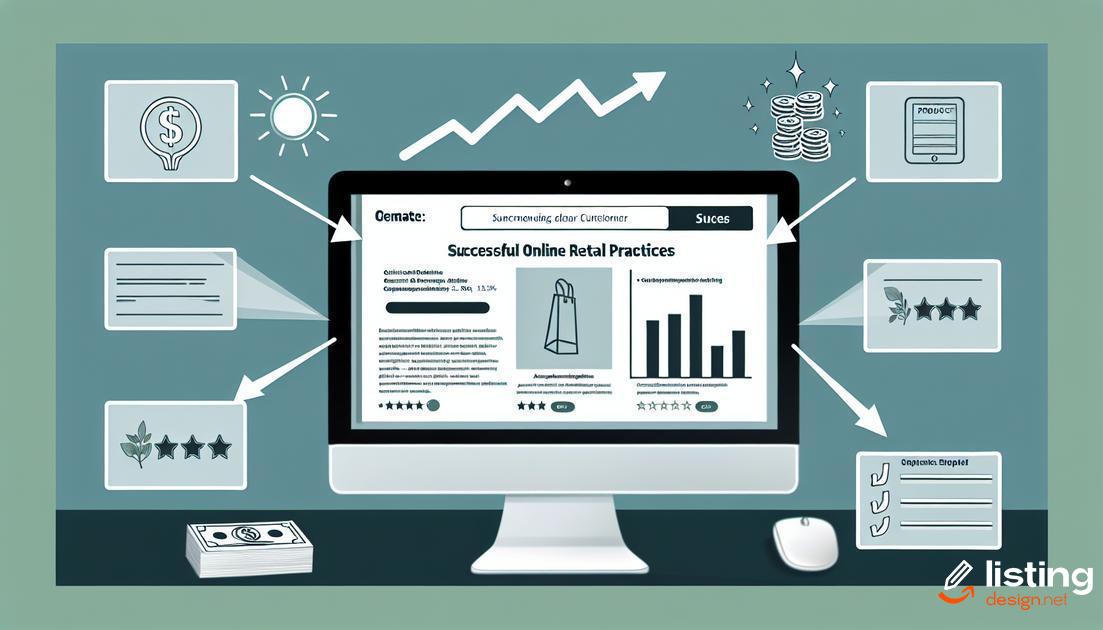In today’s competitive e-commerce landscape, mastering the best practices for Amazon listings is essential for boosting visibility and sales. An optimized listing not only attracts shoppers but also converts them into loyal customers. By focusing on product titles, descriptions, images, and customer reviews, sellers can significantly enhance their Amazon presence.
Table of Contents
Optimize Your Product Title
Optimizing your product title is crucial for attracting potential buyers. The title is the first thing customers see, so it should be both informative and appealing.
- Include Key Features: Highlight essential features and benefits in your product title. Include details like size, color, and material to make it easier for customers to understand your product at a glance.
- Use Relevant Keywords: Incorporate primary and secondary keywords that potential buyers are likely to use when searching for products similar to yours. This helps improve your listing’s visibility in search results.
- Keep It Clear and Concise: Your product title should be straightforward and easy to read. Avoid stuffing too many keywords or using complex language. Aim for a title length that balances information and readability, ideally between 60-80 characters.
- Brand Name Placement: Always start your product title with your brand name. This not only builds brand recognition but also helps customers quickly identify the product.
- Order of Information: Follow a logical order when listing information in the title. Typically, the sequence is: Brand Name, Main Keyword, Key Feature, Product Type, and Size/Quantity.
- Use Capital Letters Appropriately: Capitalize the first letter of each word in your product title except for conjunctions and prepositions unless they are the first word. This format enhances readability and professional appearance.
By optimizing your product title, you can significantly improve your product’s visibility and appeal to potential customers, leading to better engagement and higher sales.
Craft Compelling Bullet Points

When creating bullet points for your Amazon listings, focus on clarity and benefits. Each bullet point should clearly communicate a key feature or benefit of your product. Start with a strong action verb to immediately grab the reader’s attention. For example:
- Improve Convenience: Highlight features that make your product easy to use or save time for the user.
- Enhance Quality: Emphasize any high-quality materials or craftsmanship that make your product superior to others.
- Boost Confidence: Include any guarantees or certifications that reassure the buyer of their purchase decision.
Use SEO-friendly keywords naturally within your bullet points, but avoid keyword stuffing. Keep each bullet point concise, ideally under 150 characters, to ensure they are easily scannable. This technique helps in enhancing readability and retention of information.
Use High-Quality Images
Use High-Quality Images to Showcase Your Products
When creating your Amazon listing, ensure you use clear, high-quality images that showcase your product in the best light. Images should be well-lit and taken from multiple angles to provide customers with a comprehensive view of the product. Aim for images with a white background to maintain consistency across your listings.
Meet Amazon’s Image Requirements
Amazon has specific requirements for product images. Your images should be at least 1000 pixels on its longest side and 500 pixels on its shortest side. This resolution ensures that your images are zoomable, allowing customers to see finer details. Ensure the main image only shows the product that is being sold with no accessories unless specified.
Highlight Key Features
Include images that demonstrate the main benefits and uses of the product. For example, if you are selling a kitchen appliance, include images of it in use, as well as close-ups of its unique features. Consider adding lifestyle images that show your product in a real-world setting.
Use Infographics
Infographics can be particularly effective in highlighting key product specifications and features. Use text overlays on images to point out unique selling points. This can help in quickly communicating essential information to potential buyers and can be much more engaging.
Consistency is Key
Maintain a consistent style and quality throughout all your product images. This consistency not only makes your listings look professional but also helps in building brand recognition. Avoid using overly edited images that might mislead customers.
Test Different Images
Don’t hesitate to A/B test different images to see which ones convert better. Small changes, like lighting adjustments or a different angle, can sometimes make a significant difference in attracting more buyers. Regularly review and update your images based on customer feedback and performance data.
Enhance Product Descriptions

To enhance your product descriptions effectively, it’s essential to focus on clarity and relevance. Begin by thoroughly describing your product’s features and benefits. Make sure the text is easy to read and understand, targeting a wide audience.
Use bullet points to highlight key features. This breaks down information into digestible chunks, aiding readability and engagement. Including targeted keywords naturally within the description can boost your product’s visibility in search results.
Appeal to Emotions
While describing the product, address potential customers’ needs and problems. Show how your product is the ideal solution. Engaging emotionally can significantly impact buying decisions.
Provide Detailed Information
Potential buyers are keen on specifics. Include details such as dimensions, weight, material, and usage instructions. The more information you provide, the more confident a customer will feel about making a purchase.
Consider adding multimedia elements like videos or infographics to demonstrate the product in use. This can make the description more dynamic and informative.
Ensuring your descriptions are free of errors, consistent in tone, and professional can also enhance the trustworthiness and appeal of your product listings.
Leverage Backend Keywords
Backend keywords are essential for your product’s visibility on Amazon. Although these keywords are not visible to buyers, they play a crucial role in how your product is indexed and discovered by Amazon’s search algorithm. Ignoring backend keywords can severely limit your product’s reach.
Identify the right keywords to include as backend keywords by conducting thorough keyword research. Tools like Helium 10, Jungle Scout, and MerchantWords can assist you in identifying high-volume search terms relevant to your product. Additionally, consider using synonyms, regional variations, and common misspellings to expand your reach.
It is important to follow Amazon’s guidelines for backend keywords. You are given 250 bytes for backend keywords, so use this space wisely. Separate the words with spaces and avoid punctuation. Do not repeat words, as this does not add value and may even lead to keyword stuffing, which Amazon penalizes.
Regularly reviewing and updating your backend keywords ensures they remain relevant and effective. As market trends change and new keywords emerge, adapting your strategy can prevent your listings from becoming stagnant. By leveraging backend keywords efficiently, you ultimately enhance your product’s visibility and boost your sales.
Gain Customer Reviews

Customer reviews play a crucial role in the success of your Amazon listings. They not only provide social proof but also help improve your product’s visibility on the platform.
Encourage satisfied customers to leave reviews by sending follow-up emails after a purchase. Use these emails to express gratitude and politely ask for feedback. Make sure the process is straightforward by providing direct links to the review page.
Utilize Amazon’s ‘Request a Review’ Button: This feature allows you to request a review directly from the order details page. It’s a simple and effective way to gather feedback without violating Amazon’s policies.
Incorporate Customer Feedback: Pay attention to the feedback you receive. Positive reviews can highlight what customers love about your product, while negative reviews can provide valuable insights into areas that need improvement. Address any recurring issues as soon as possible to enhance customer satisfaction.
Offer Incentives Within Amazon’s Guidelines: Incentives can be a great way to encourage reviews, but be cautious. Amazon’s policies prohibit offering compensation in exchange for reviews. Instead, focus on exceptional customer service, fast shipping, and high-quality products to naturally earn positive feedback.
Respond to Reviews:
Show customers that you value their opinions by responding to both positive and negative reviews. Thank customers for their positive feedback and address any concerns raised in negative reviews. This interaction builds trust and shows potential buyers that you are committed to customer satisfaction.
Analyze Competitor Listings
Examining how your competitors present their product listings can offer valuable insights. Start by identifying top sellers within your niche and scrutinize their listings. Note their product titles and bullet points. Observe the structure and the kind of language they use. Do they employ specific keywords that you might be missing?
Pay attention to the images they utilize. Are they high-quality and diverse? Look at their product descriptions and see if they provide comprehensive and engaging content. Analyzing reviews can also highlight what customers appreciate or dislike, giving you clues to improve your own listing.
Finally, examine their pricing strategies and how frequently they update their listings. This analysis can reveal trends and strategies, helping you to refine your own approach.
Monitor and Adjust Listings

To ensure your Amazon listing stays competitive and continues to drive conversions, it is crucial to regularly monitor and adjust your listings. Start by tracking your sales data, conversion rates, and customer feedback to identify performance trends. Analyze which keywords are driving traffic and whether they align with your sales goals.
Utilize Amazon’s Search Term Reports to gather insights into customer search behaviors and refine your backend keywords accordingly. Check for any changes in Amazon’s A9 algorithm and adjust your listing to comply with new best practices.
Another critical aspect is to review and update your product images routinely, ensuring they meet the latest Amazon image requirements and reflect your product’s key features. Keep an eye on competitor listings to spot any changes in their strategy that might influence your market position.
Stay vigilant for customer reviews and Q&As. Address any common concerns or questions directly in your product description or bullet points to improve clarity and build trust. Use Amazon’s Automated Pricing tool to remain competitive without eroding your profit margins.
Regularly update your listings based on seasonal trends, holidays, or any new features added to your product line. This continual monitoring and adjustment will help ensure your listings stay optimized, ultimately boosting your sales effectively.


